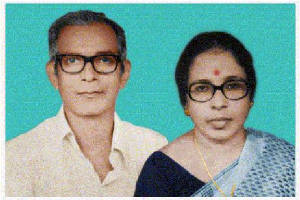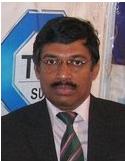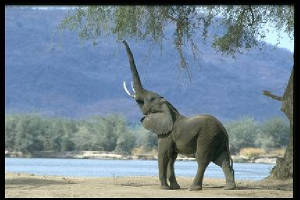|
"Tiruvilwamala"
is the right way to write it also the equivalents that you will find are "Tiruvilvamala", "Thiruvilvamala", "Thiruvilwamala",
"Thiruvilyamala", "Tiruvilyamala", "Thiruwilyamala", "Tiruwilyamala", "Thiruvillamala", "Tiruvillamala" Among the three famous
temples dedicated to Sri Rama in Kerala, Tiruvilwamala is the foremost, the image here being self born. The other two temples
are Triprayar near Trichur and Tiruvangad in North Kerala. Similarly, there are only a few temples for Lakshmana in India, let alone in Kerala. There is one temple at Vennimala
some 8km away from Kottayam. But it is not as well known as Tiruvilwamala. To the south of the sanctum is the little Ganapati
shrine, which faces east. The east facing image (Lakshmana) is believed to be an image of Vishnu held in worship by Shiva.
It is said to have been granted to Parasurama (yet another incarnation of Vishnu) who is said to have established the image
here and initiated a worship protocol. The west facing image is said to have been installed by a sage by name Aamalaka who
with intense fervor prayed to Vishnu and requested that he take up abode on the Vilvadri hill. Outside the temple and down
below on the southern side a flight of stone steps lead to the shrine of Hariharaputra or Ayyappa installed on the same pedestal
as Siva and Parvati. The entire courtyard of the temple is paved with stone slabs. On the north side is the temple tank. There
is no well inside the temple which is another peculiarity. The water required for daily worship is drawn from a tank situated
in the northeast side. Therefore no one is allowed to use this tank. If any pollution is suspected water is brought from the
nearby Bharatapuzha. The popular belief is that darshan of both Tirunavayi and Tiruvilwamala on one and the same day is very
auspicious. Since seeing the light of temple even from a distance is equal to seeing the deity, lights in the towers were
prohibited. It was ordained by the Lord that the real Bhakta should come physically to Tiruvilwamala and pray rather than
adopt the short cut of viewing the lights from Tirunavayi. Legend The story goes that once the temple priests sleeping on
the top storey of the gopuram lighted a lamp and some of them went to Tirunavayi to see if the lights could be really seen
from there. They did see the lamp and they showed it to others as well. The very next day the gopuram was struck by lightning
and thunder and was razed to the ground. They have not been rebuilt since. According to legend, the eastern idol is the earlier
one and was installed by Parasurama himself. It is a stone image about three feet in height. When decorated with gold ornaments,
flower garlands and diamond diadem the little image shines and is beautiful to behold. Sri Vilwadri Mahatmya, a Sanskrit text
with 18 chapters, describes the origin of this ancient temple. It is in the form of a conversation between Uma (Parvati) and
Maheswara (Siva). According to this, Bhargava Rama, as Parasurama is called, prayed to Siva for the liberation of his pitrus.
Pleased with the prayers of Parasurama, Parameswara granted him the image of Vishnu which He Himself was worshipping. Parasurama,
in his search for a suitable place for the installation of the deity, came across the beautiful Vilwadri, full of Amala trees.
He constructed a temple here, consecrated the deity and laid down the pooja routine. He brought the pirtus and got them liberated
as a result of the darshan of the divine deity. The place he settled down finally is still known as Bhutan mala. Self born Image The image in the sanctum facing west is Swayambhu
or self born. It is four to five feet tall and is permanently fitted with a gold plated cover for the protection of the image
and hence never renewed. Once a priest while trying to remove the coverings damaged the idol slightly. Thereafter it was decided
to fit it permanently. The cover is in two portions one up to the waist and the other above both so dexterously joined together
as not to be visible as separate ones. It is said that there used to be a hole on the pedestal in front of the deity.. The.
water filled here was served as tirtha. Once a piece of kadali plantain fell into this. The priest tried to remove this by
piercing the hole with a sharp instrument. He heard a cracking sound of the stone and the tool fell from his hand. The tirtha
also dried up subsequently. It is believed that below the sanctum there is a cave and also a golden Vilwa tree. Some say,
it is because of this that the place came to be called Vilwamala. According to another legend when the power of the Vishnu
deity increased enormously the asuras foared their end would come soon. To prevent this one asura assumed the guise of a Brahmin
and came to the temple. He mixed freely with other Brahmins and participated in the temple feast with them. At night he would
haunt the temple, would kill the cows and other animals and eat their flesh. He throw the bones and horns at one place which
became a heap. This is still called muri kunnu (muri means ox and kunnu means hill.) This aroused the suspicion of other people
who were frightened beyond their wits. They prayed to God. One dark night in the month of Kumbha when everyone was fast asleep
the asura broke open the sanctum and tried to destroy the idol. Then Mahavishnu assumed the form of Narasimha half man and
half lion and tore him to death. Hearing the asura┬’swailings people came but were also frightened by the fierce form
of the God. At this juncture Vilwamangalathu Swamiyar appeared and he praised the Lord with stotras, addressing him as Vilwadrinatha.
The Bhagawan calmed and assumed his benign form. People were overjoyed and started addressing him as Vilwadrinatha after the
sage. Rigorous Tapas The story of the origin of the Swayambhu deity in the west Nada is also related in the Vilwadri Mahatmya
referred to earlier. According to this, Aamalakan, the son of Kashyapa Prajapati, started a rigorous tapas to propitiate Mahavishnu.
lndra thought his objective was to conquer Swarga. He, therefore, deputed the celestial beauties Urvasi, Rambha and Tilottama
to interrupt his tapas. But they failed in this. Therefore he approached Kashyapa himself who explained to lndra that Aamalakan
had no ambition nor was he interested in things transient. He was only interested in attaining unstinted devotion to God.
lndra felt happy and left. But the asuras became panicky. They thought this severe penance would bring about their ruin. They
decided to end it by adopting various means, by creating terror in Aamalakan. But the latter opened his eyes which emitted
sparks of fire which ultimately turned into a huge fire. The asuras became breathless and died on the spot. The heap of the
dead was transformed into rock which is even now known as rakshasapaara (paara moaning rock) to the south east of the present
temple. Sage Aamalakan continued his prayer. Pleased by his perseverance, the four armed Mahavishnu adorned with conch, etc.,
accompanied by Lakshmi and Bhudevi with Adisesha as his canopy, appeared before him. The sage shad tears of joy and bowed
before Bhagawan. Mahavishnu asked devotee to name any boon. Aamalakan said that he desired nothing in this world, not even
heaven. What he wanted was achanchala bhakti, unstinted devotion. He also requested the Lord to remain there for the protection
of those who suffer in this samsara. Mahavishnu agreed and transferred his image to the deity. Thus both vigrahas facing east
and west are of Mahavishnu. Aamalaka Maharshi used to chant Rama┬’s names while doing japas on the west side. Hence
people praying here also uttered Rama nama and worshipped the deity as Sri, Rama. Consequently the idol on the east side came
to be regarded as Lakshmana, Rama┬’s brother and life breath Festivals The important annual festival here is Ekadasi
in the Malayalam month of Kumbha (February March). On Ashtami, Navami and Ekadasi days there is vilakku (festival of lights),
niramalas (decoration with flower garlands) and elephant processions, Elaborate feasts used to be held in the past, which
like other temples have been discontinued with the change of times. On Ekadasi day, of course, hundreds of devotees observe
fast and forgo their sleep. They spend their time in temples in prayers and in witnessing a variety of entertainment┬’s
given freely by famed artistes. Trichur, an abbreviation of 'TiruShiva Perur', or the town with the name of Lord Shiva, is
appropriately named. The central and most important feature of this, one of the major cities of North
Kerala, is Vadakkunath Kshetram where the reigning deity is Lord Shiva. Situated on a hillock right in the centre
of the city, the spaciously laid out 'kshetram', or temple, attracts thousands of devotees from all over the land. Tiruvilvamala,
located north of Thrissur in Kerala houses the twin temple complex atop the Vilvadri hill, dedicated to Rama and Lakshmana.
As in the case of Triprayar, Moozhikkalam, Irinjalakuda and Payyamel, the images held in reverence here are those of Maha
Vishnu, worshipped as Rama and Lakshmana respectively. The name Vilvamala or Vilvadri arises from the belief that there is
a subterranean chamber beneath the temple housing a golden vilva tree. The Bharatapuzha river About half a mile north of Tiruvilvamala
is the Bharatapuzha river, considered to be the Ganges of Kerala. Tiruvilvamala, Tirunaavai,
Tiruvituvakkode, Tirthala and Tiruchikuzhi are five of the shrines along the course of the river. It is believed that Tiruvilvamala
is to the Bharatapuzha river what the Manikarnika ghat in Benares is to the Ganges. To the
east of the Tiruvilvamala temple is a cave, known as the Punarjanani. It is believed that trekking through this cave would
end one's cycle of births and deaths. It is only on the Ekadasi day in the month of Scorpio that this pilgrimage is undertaken.
Architecture The temple complex consists of two sancta with pyramidal two tiered copper plated roofs with gables. There is
no flagstaff here as in Triprayar. The entire temple complex has ornamental gopuradwaras or entry tower bases, without the towers. It is believed that the towers that existed here used to be lit at night and
that the lighted towers used to be visible from as far away as Tirunaavai, and that the towers were struck down by lightning.
The two shrines house images of Mahavishnu. The west facing sanctum houses a five feet tall gold plated image of chaturbhuja
Vishnu. The gold kavacam covers what is believed to be a svayamvyakta (self created) image. The gold covering is never removed.
The east facing shrine houses a three feet tall stone image of Mahavishnu and is decorated with fine jewelry and garlands.
While the west facing image is worshipped as Rama, the east facing image which is believed to be older is worshipped as Lakshmana.
Also in this temple are shrines to Ganapati and Saasta. The current structure is largely a result of renovationions carried
out by the rulers of Cochin in late 19th century after a
devastating fire destroyed much of the temple. Prior to it it had been renovated in mid ninteenth century, and prior to it
it had been attacked by the armies of Tippu Sultan in the 18th century. Festivals The annual festival here falls on the Ekadasi
day in the month of Pisces (February March)
|







